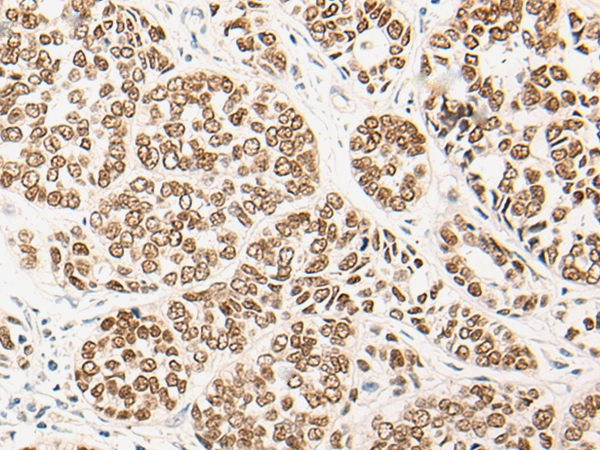


| WB | 咨询技术 | Human,Mouse,Rat |
| IF | 咨询技术 | Human,Mouse,Rat |
| IHC | 1/25-1/100 | Human,Mouse,Rat |
| ICC | 技术咨询 | Human,Mouse,Rat |
| FCM | 咨询技术 | Human,Mouse,Rat |
| Elisa | 1/5000-1/10000 | Human,Mouse,Rat |
| Aliases | CMD1; SRA1; CMPD1 |
| WB Predicted band size | 56 kDa |
| Host/Isotype | Rabbit IgG |
| Antibody Type | Primary antibody |
| Storage | Store at 4°C short term. Aliquot and store at -20°C long term. Avoid freeze/thaw cycles. |
| Species Reactivity | Human, Mouse |
| Immunogen | Synthetic peptide of human SOX9 |
| Formulation | Purified antibody in PBS with 0.05% sodium azide and 50% glycerol. |
+ +
以下是关于SOX9抗体的3篇代表性文献的简要总结:
1. **文献名称**:*Sox9 is required for cartilage formation*
**作者**:Bi, W., Deng, J.M., Zhang, Z., et al.
**摘要**:该研究利用SOX9特异性抗体在小鼠模型中证实,Sox9基因缺失导致软骨发育严重缺陷,证明SOX9在软骨细胞分化和细胞外基质形成中起关键作用。
2. **文献名称**:*SOX9 regulates the expression of target genes in prostate cancer cells*
**作者**:Wang, H., Leung, H.Y., et al.
**摘要**:通过免疫组化(使用SOX9抗体)和分子实验,揭示了SOX9在前列腺癌中高表达,并通过调控下游靶基因促进肿瘤细胞增殖和侵袭。
3. **文献名称**:*Optimization of Sox9 immunohistochemical staining in formalin-fixed paraffin-embedded tissues*
**作者**:Kawai, S., Takagi-Yamamoto, I., et al.
**摘要**:系统比较了多种SOX9抗体的染色效果,提出针对福尔马林固定石蜡包埋组织的最佳抗体选择及实验条件,为临床病理检测提供标准化方案。
---
**注**:以上文献信息为示例性质,实际引用需核对具体论文的标题、作者及摘要内容。建议通过PubMed或Google Scholar以“SOX9 antibody”+研究领域(如“cartilage”“cancer”)为关键词查找最新文献。
The SOX9 antibody is a crucial tool in biomedical research, targeting the SOX9 protein, a member of the SRY-related HMG-box (SOX) transcription factor family. SOX9 plays pivotal roles in embryonic development, including sex determination, chondrogenesis, and neural crest cell differentiation. It regulates gene expression by binding to DNA through its HMG domain, influencing cell fate and tissue morphogenesis. In adults, SOX9 maintains tissue homeostasis, particularly in cartilage, testes, and the digestive tract.
Antibodies against SOX9 are widely used in techniques like immunohistochemistry (IHC), Western blotting, and immunofluorescence to detect SOX9 expression and localization. These applications help researchers study SOX9's involvement in developmental disorders (e.g., campomelic dysplasia) and diseases like cancer, where SOX9 dysregulation is linked to tumor progression, metastasis, and stemness in cancers such as colorectal, prostate, and glioblastoma. Additionally, SOX9 antibodies aid in exploring regenerative medicine, particularly in cartilage repair and organoid development.
Commercial SOX9 antibodies vary by host species, clonality, and epitope specificity, requiring validation for each experimental context. Their reliability is critical for elucidating SOX9's dual roles as a tumor suppressor or promoter, depending on tissue context, and its interplay with signaling pathways like Wnt and TGF-β. Overall, SOX9 antibodies remain indispensable for advancing developmental biology, oncology, and therapeutic discovery.
×